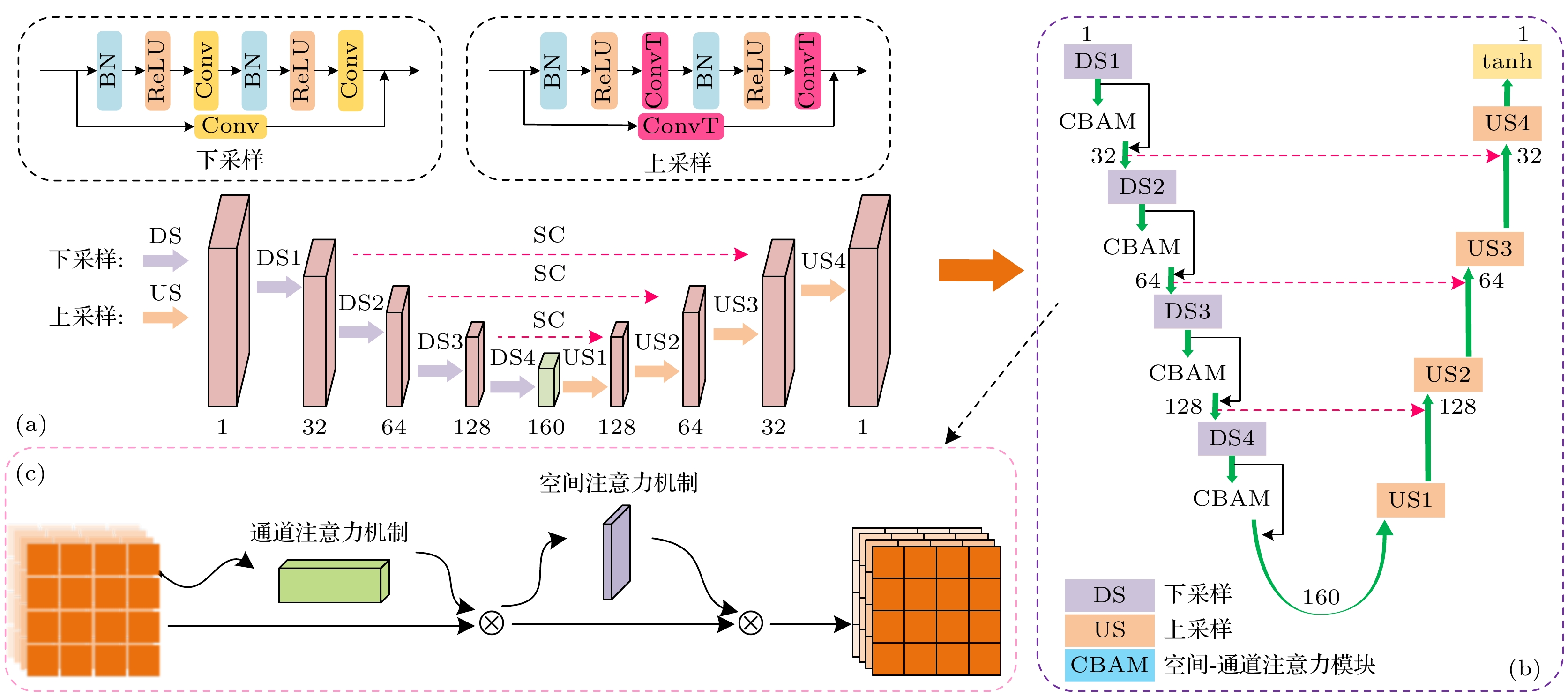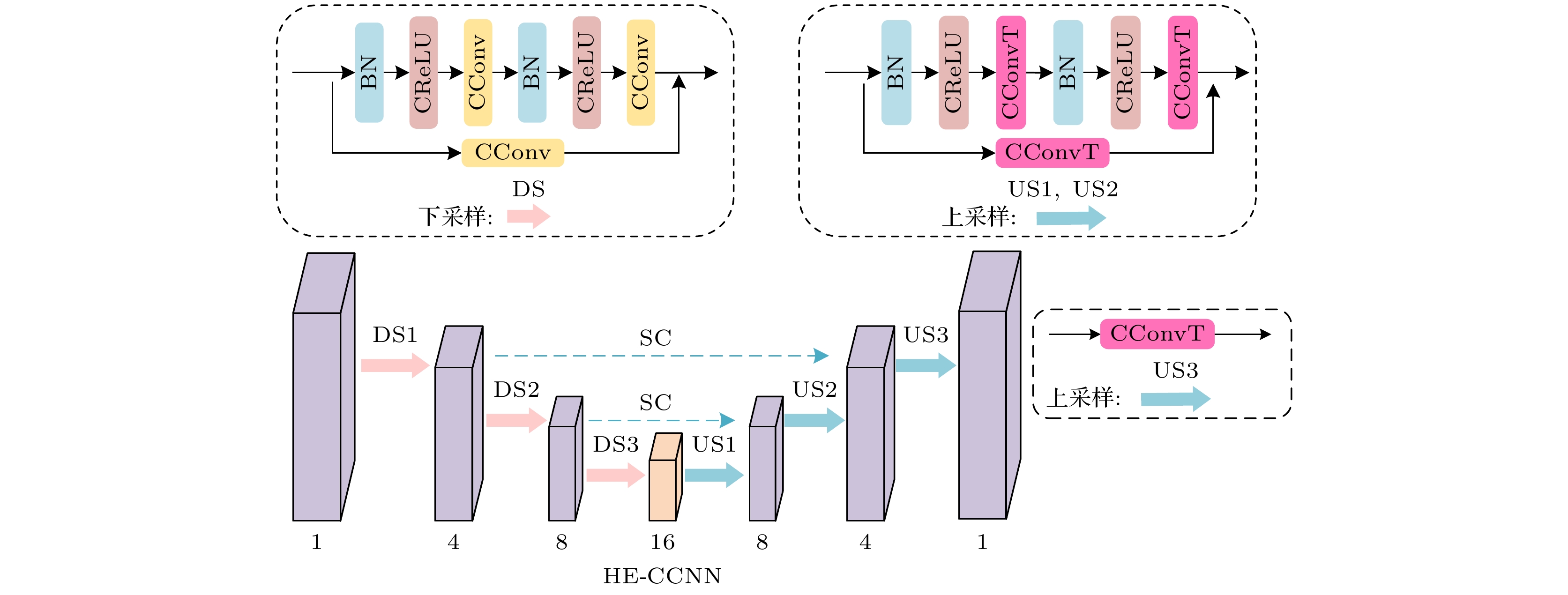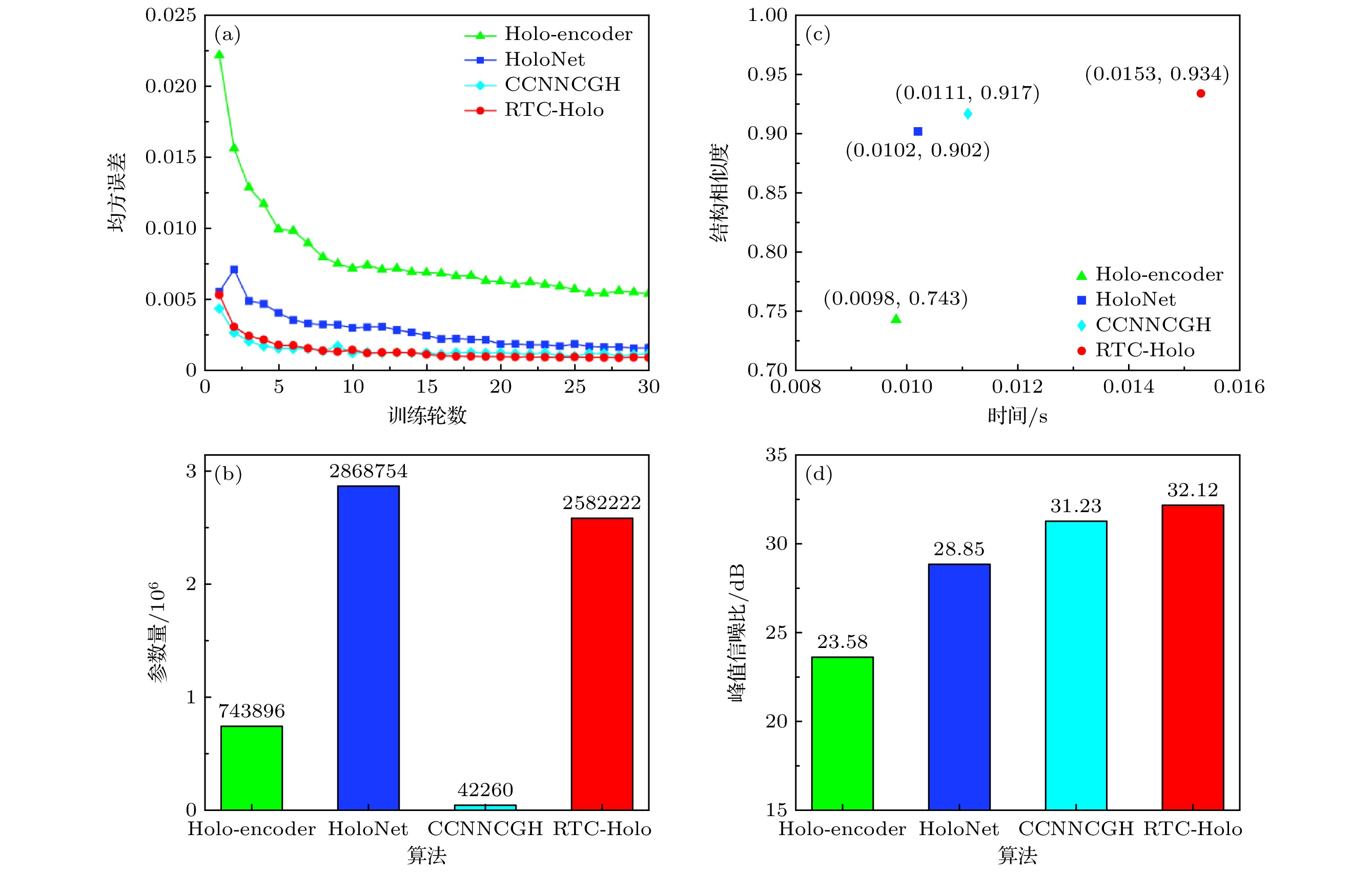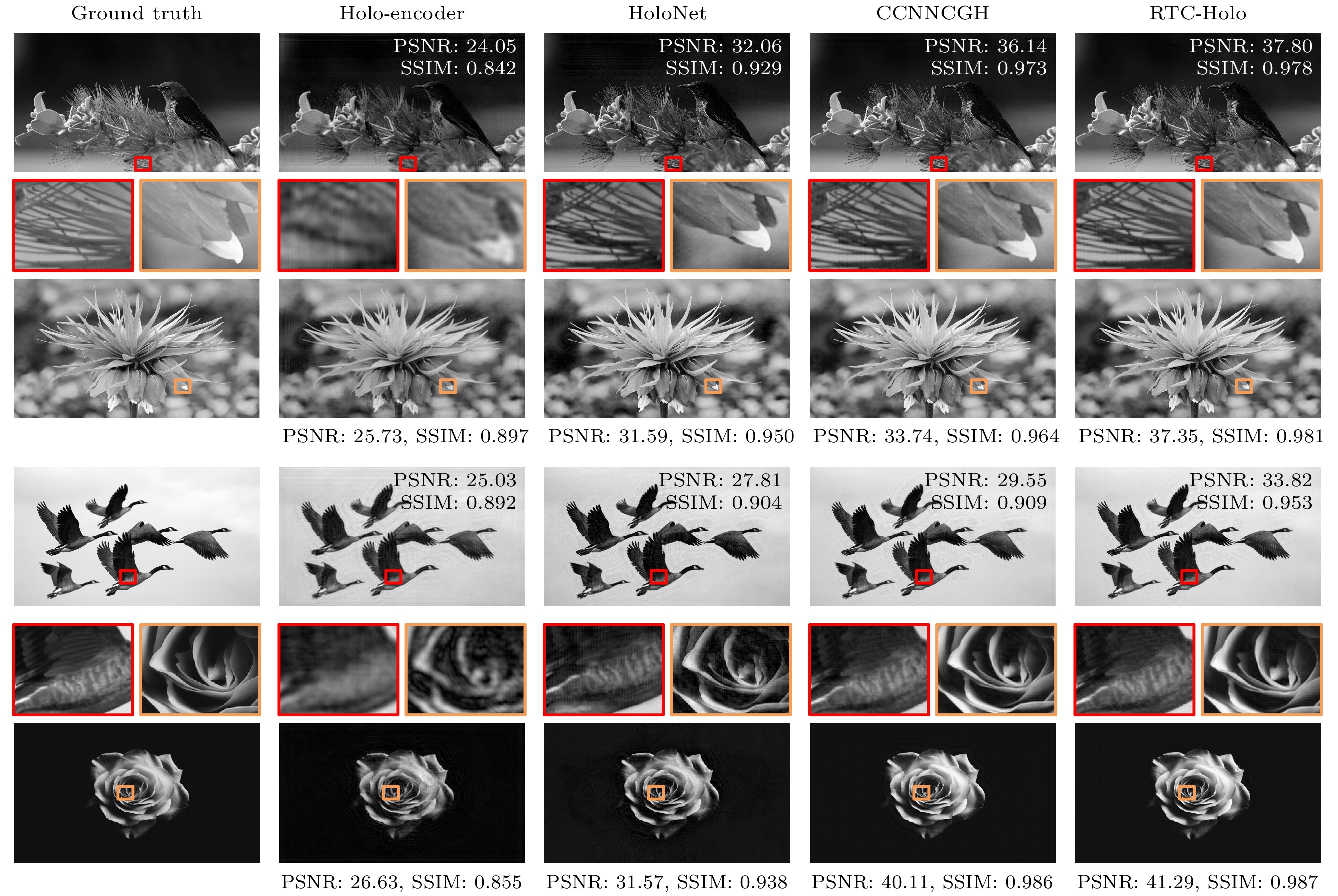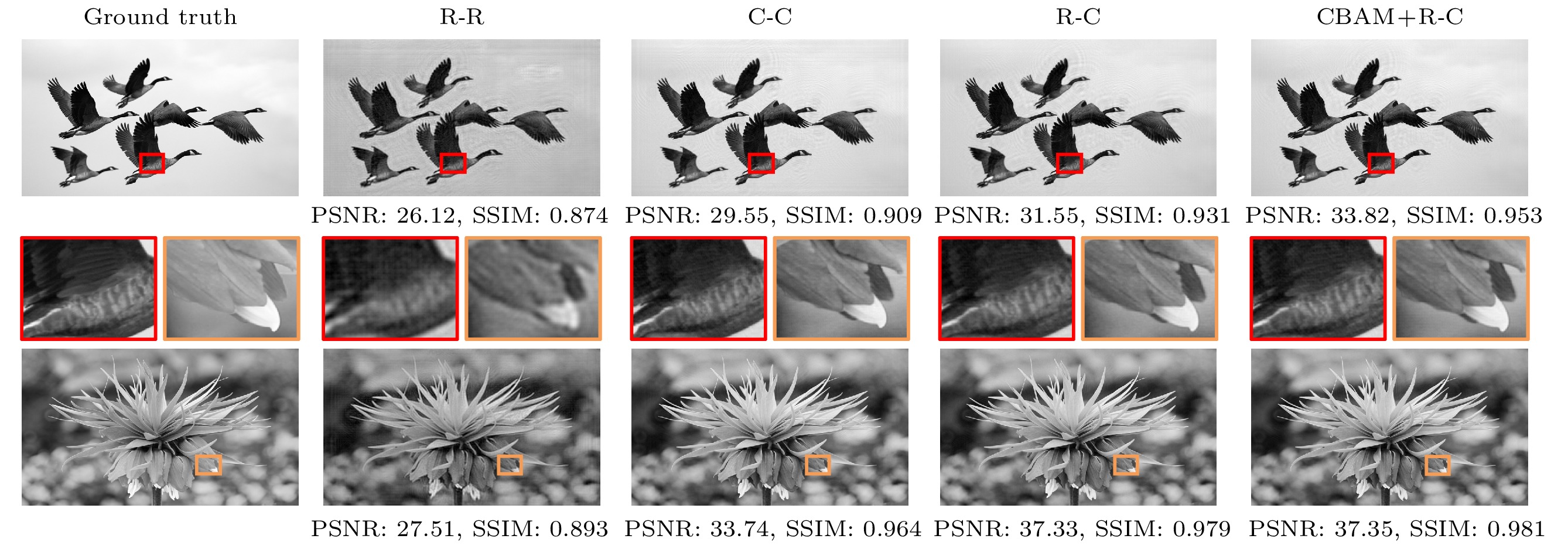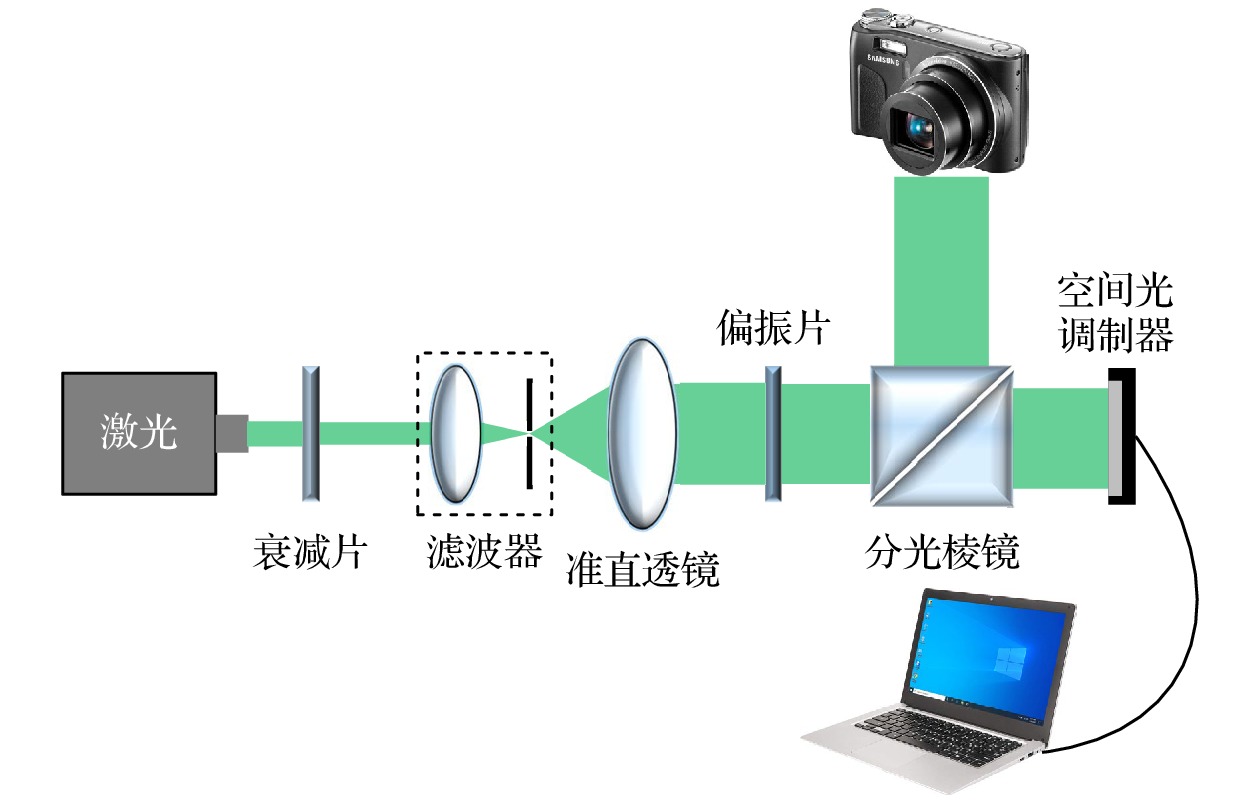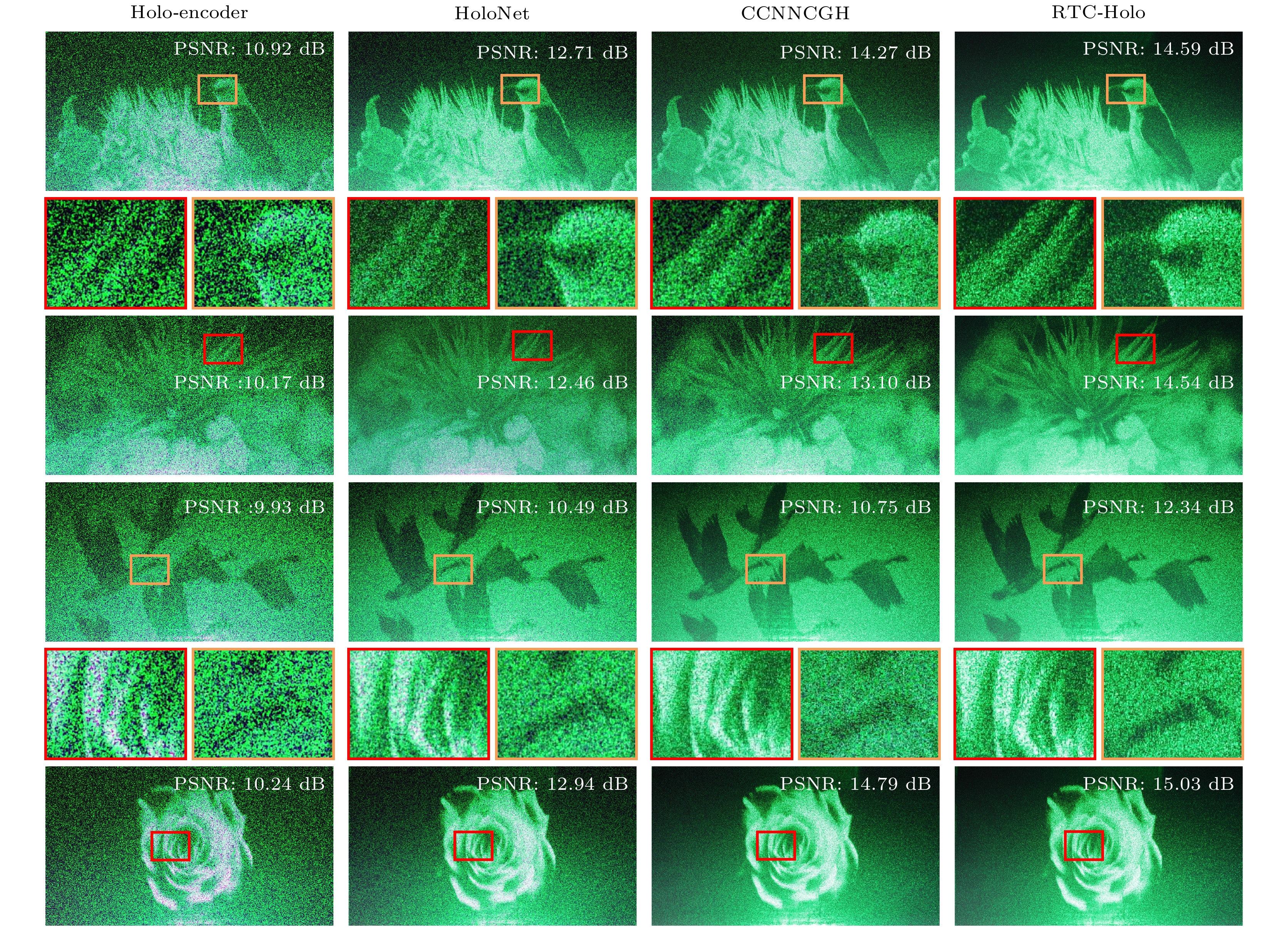-
针对目前深度学习算法难以实现快速高质量全息图的生成, 提出了一种注意力卷积神经网络算法(RTC-Holo), 在快速生成全息图的同时, 提高了全息图的生成质量. 整个网络由实值和复值卷积神经网络组成, 实值网络进行相位预测, 复值网络对空间光调制器(spatial light modulator, SLM)面的复振幅进行预测, 预测后得到的复振幅的相位用于全息编码和数值重建. 在相位预测模块的下采样阶段引入注意力机制, 增强相位预测模块下采样阶段的特征提取能力, 进而提升整个网络生成纯相位全息图的质量. 将精准的角谱衍射模型(angular spectrum method, ASM)嵌入到整个网络中, 以无监督的学习方式进行网络训练. 本文提出的算法能够在0.015 s内生成平均峰值信噪比(peak signal-to-noise ratio, PSNR)高达32.12 dB的2K (即分辨率为1920×1072)全息图. 数值仿真和光学实验验证了该方法的可行性和有效性.In recent years, with the significant improvement of computer performance, deep learning technology has shown an explosive development trend and has been widely used in various fields. In this context, the computer-generated hologram (CGH) generation algorithm based on deep learning provides a new method for displaying the real-time high-quality holograms. The convolutional neural network is a most typical network structure in deep learning algorithms, which can automatically extract key local features from an image and construct more complex global features through operations such as convolution, pooling and full connectivity. Convolutional neural networks have been widely used in the field of holographic displays due to their powerful feature extraction and generalization abilities. Compared with the traditional iterative algorithm, the CGH algorithm based on deep learning has a significantly improved computing speed, but its image quality still needs further improving. In this paper, an attention convolutional neural network based on the angular spectrum diffraction model is proposed to improve the quality as well as the speed of generating holograms. The whole network consists of real-valued and complex-valued convolutional neural networks: the real-valued network is used for phase prediction, while the complex-valued network is used to predict the complex amplitude of the SLM surface, and the phase of the complex amplitude obtained after prediction is used for holographic coding and numerical reconstruction. An attention mechanism is embedded in the down sampling stage of the phase prediction network to improve the feature extraction capability of the whole algorithm, thus improving the quality of the generated phase-only holograms. An accurate diffraction model of the angular spectrum method is embedded in the whole network to avoid labeling the large-scale datasets, and unsupervised learning is used to train the network. The proposed algorithm can generate high-quality 2K (resolution ratio of 11920×1072) holograms within 0.015 s. The average peak signal-to-noise ratio of the reconstruction images reaches up to 32.12 dB and the average structural similarity index measure of the generated holograms can achieve a value as high as 0.934. Numerical simulations and optical experiments verify the feasibility and effectiveness of the proposed attentional convolutional neural network algorithm based on the diffraction model of angular spectrum method, which provides a powerful help for applying the deep learning theory and algorithm to the field of real-time holographic display.
[1] Huang Q, Hou Y H, Lin F C, Li Z S, He M Y, Wang D, Wang Q H 2024 Opt. Lasers Eng. 176 108104
 Google Scholar
Google Scholar
[2] Yao Y W, Zhang Y P, Fu Q Y, Duan J L, Zhang B, Cao L C, Poon T C 2024 Opt. Lett. 49 1481
 Google Scholar
Google Scholar
[3] Chen C Y, Cheng C W, Chou T A, Chuang C H 2024 Opt. Commun. 550 130024
 Google Scholar
Google Scholar
[4] Huang X M, Zhou Y L, Liang H W, Zhou J Y 2024 Opt. Lasers Eng. 176 108115
 Google Scholar
Google Scholar
[5] Shigematsu O, Naruse M, Horisaki R 2024 Opt. Lett. 49 1876
 Google Scholar
Google Scholar
[6] Gu T, Han C, Qin H F, Sun K S 2024 Opt. Express 32 44358
 Google Scholar
Google Scholar
[7] Wang D, Li Z S, Zheng Y, Zhao Y R, Liu C, Xu J B, Zheng Y W, Huang Q, Chang C L, Zhang D W, Zhuang S L, Wang Q H 2024 Light: Sci. Appl. 13 62
 Google Scholar
Google Scholar
[8] Wang Y Q, Zhang Z L, Zhao S Y, He W, Li X T, Wang X, Jie Y C, Zhao C M 2024 Opt. Laser Technol. 171 110372
 Google Scholar
Google Scholar
[9] Yao Y W, Zhang Y P, Poon T C 2024 Opt. Lasers Eng. 175 108027
 Google Scholar
Google Scholar
[10] Madali N, Gilles A, Gioia P, MORIN L 2024 Opt. Express 32 2473
 Google Scholar
Google Scholar
[11] Tsai C M, Lu C N, Yu Y H, Han P, Fang Y C 2024 Opt. Lasers Eng. 174 107982.
 Google Scholar
Google Scholar
[12] Zhao Y, Cao L C, Zhang H, Kong D Z, Jin G F 2015 Opt. Express 23 25440
 Google Scholar
Google Scholar
[13] Gerhberg R W, Saxton W O 1972 Optik 35 237
[14] Liu K X, He Z H, Cao L C 2021 Chin. Opt. Lett. 19 050501
 Google Scholar
Google Scholar
[15] Sui X M, He Z H, Jin G F, Cao L C 2022 Opt. Express 30 30552
 Google Scholar
Google Scholar
[16] Kiriy S A, Rymov D A, Svistunov A S, Shifrina A V, Starikov R S, Cheremkhin P A 2024 Laser Phys. Lett. 21 045201
 Google Scholar
Google Scholar
[17] Li X Y, Han C, Zhang C 2024 Opt. Commun. 557 130353
 Google Scholar
Google Scholar
[18] Qin H F, Han C, Shi X, Gu T, Sun K S 2024 Opt. Express 32 44437
 Google Scholar
Google Scholar
[19] Yan X P, Liu X L, Li J Q, Hu H R, Lin M, Wang X 2024 Opt. Laser Technol. 174 110667
 Google Scholar
Google Scholar
[20] Yu G W, Wang J, Yang H, Guo Z C, Wu Y 2023 Opt. Lett. 48 5351
 Google Scholar
Google Scholar
[21] Liu Q W, Chen J, Qiu B S, Wang Y T, Liu J 2023 Opt. Express 31 35908
 Google Scholar
Google Scholar
[22] Horisaki R, Takagi R, Tanida J 2018 Appl. Opt. 57 3859
 Google Scholar
Google Scholar
[23] Lee J, Jeong J, Cho J, Yoo D, Lee B, Lee B 2020 Opt. Express 28 27137
 Google Scholar
Google Scholar
[24] Chang C L, Wang D, Zhu D C, Li J M, Xia J, Zhang X L 2022 Opt. Lett. 47 1482
 Google Scholar
Google Scholar
[25] Wu J C, Liu K X, Sui X M, Cao L C 2021 Opt. Let. 46 2908
 Google Scholar
Google Scholar
[26] Shui X H, Zheng H D, Xia X X, Yang F R, Wang W S, Yu Y J 2022 Opt. Express 30 44814
 Google Scholar
Google Scholar
[27] Peng Y F, Choi S, Padmanaban N, Wetzstein G 2020 ACM Trans. Graphics 39 1
[28] Zhong C L, Sang X Z, Yan B B, Li H, Chen D, Qin X J, Chen S, Ye X Q 2023 IEEE Trans. Visual Comput. Graphics 30 1
-
图 4 算法数值仿真对比 (a)算法30轮训练的损失函数对比折线图; (b)算法参数量对比柱状图; (c)算法SSIM-Time对比散点图; (d)算法PSNR对比柱状图
Fig. 4. Algorithm numerical simulation comparison: (a) Line graph of loss function comparison for 30 training rounds of the algorithm ; (b) histogram of algorithm parameter count comparison; (c) scatter plot of algorithm SSIM-Time comparison; (d) histogram of algorithm PSNR comparison.
表 1 网络结构数值仿真对比
Table 1. Comparison of numerical simulation of network structures.
网络结构 R-R C-C R-C CBAM+R-C PSNR/dB 27.89 31.23 31.59 32.12 SSIM 0.891 0.917 0.925 0.934 -
[1] Huang Q, Hou Y H, Lin F C, Li Z S, He M Y, Wang D, Wang Q H 2024 Opt. Lasers Eng. 176 108104
 Google Scholar
Google Scholar
[2] Yao Y W, Zhang Y P, Fu Q Y, Duan J L, Zhang B, Cao L C, Poon T C 2024 Opt. Lett. 49 1481
 Google Scholar
Google Scholar
[3] Chen C Y, Cheng C W, Chou T A, Chuang C H 2024 Opt. Commun. 550 130024
 Google Scholar
Google Scholar
[4] Huang X M, Zhou Y L, Liang H W, Zhou J Y 2024 Opt. Lasers Eng. 176 108115
 Google Scholar
Google Scholar
[5] Shigematsu O, Naruse M, Horisaki R 2024 Opt. Lett. 49 1876
 Google Scholar
Google Scholar
[6] Gu T, Han C, Qin H F, Sun K S 2024 Opt. Express 32 44358
 Google Scholar
Google Scholar
[7] Wang D, Li Z S, Zheng Y, Zhao Y R, Liu C, Xu J B, Zheng Y W, Huang Q, Chang C L, Zhang D W, Zhuang S L, Wang Q H 2024 Light: Sci. Appl. 13 62
 Google Scholar
Google Scholar
[8] Wang Y Q, Zhang Z L, Zhao S Y, He W, Li X T, Wang X, Jie Y C, Zhao C M 2024 Opt. Laser Technol. 171 110372
 Google Scholar
Google Scholar
[9] Yao Y W, Zhang Y P, Poon T C 2024 Opt. Lasers Eng. 175 108027
 Google Scholar
Google Scholar
[10] Madali N, Gilles A, Gioia P, MORIN L 2024 Opt. Express 32 2473
 Google Scholar
Google Scholar
[11] Tsai C M, Lu C N, Yu Y H, Han P, Fang Y C 2024 Opt. Lasers Eng. 174 107982.
 Google Scholar
Google Scholar
[12] Zhao Y, Cao L C, Zhang H, Kong D Z, Jin G F 2015 Opt. Express 23 25440
 Google Scholar
Google Scholar
[13] Gerhberg R W, Saxton W O 1972 Optik 35 237
[14] Liu K X, He Z H, Cao L C 2021 Chin. Opt. Lett. 19 050501
 Google Scholar
Google Scholar
[15] Sui X M, He Z H, Jin G F, Cao L C 2022 Opt. Express 30 30552
 Google Scholar
Google Scholar
[16] Kiriy S A, Rymov D A, Svistunov A S, Shifrina A V, Starikov R S, Cheremkhin P A 2024 Laser Phys. Lett. 21 045201
 Google Scholar
Google Scholar
[17] Li X Y, Han C, Zhang C 2024 Opt. Commun. 557 130353
 Google Scholar
Google Scholar
[18] Qin H F, Han C, Shi X, Gu T, Sun K S 2024 Opt. Express 32 44437
 Google Scholar
Google Scholar
[19] Yan X P, Liu X L, Li J Q, Hu H R, Lin M, Wang X 2024 Opt. Laser Technol. 174 110667
 Google Scholar
Google Scholar
[20] Yu G W, Wang J, Yang H, Guo Z C, Wu Y 2023 Opt. Lett. 48 5351
 Google Scholar
Google Scholar
[21] Liu Q W, Chen J, Qiu B S, Wang Y T, Liu J 2023 Opt. Express 31 35908
 Google Scholar
Google Scholar
[22] Horisaki R, Takagi R, Tanida J 2018 Appl. Opt. 57 3859
 Google Scholar
Google Scholar
[23] Lee J, Jeong J, Cho J, Yoo D, Lee B, Lee B 2020 Opt. Express 28 27137
 Google Scholar
Google Scholar
[24] Chang C L, Wang D, Zhu D C, Li J M, Xia J, Zhang X L 2022 Opt. Lett. 47 1482
 Google Scholar
Google Scholar
[25] Wu J C, Liu K X, Sui X M, Cao L C 2021 Opt. Let. 46 2908
 Google Scholar
Google Scholar
[26] Shui X H, Zheng H D, Xia X X, Yang F R, Wang W S, Yu Y J 2022 Opt. Express 30 44814
 Google Scholar
Google Scholar
[27] Peng Y F, Choi S, Padmanaban N, Wetzstein G 2020 ACM Trans. Graphics 39 1
[28] Zhong C L, Sang X Z, Yan B B, Li H, Chen D, Qin X J, Chen S, Ye X Q 2023 IEEE Trans. Visual Comput. Graphics 30 1
计量
- 文章访问数: 2325
- PDF下载量: 93
- 被引次数: 0













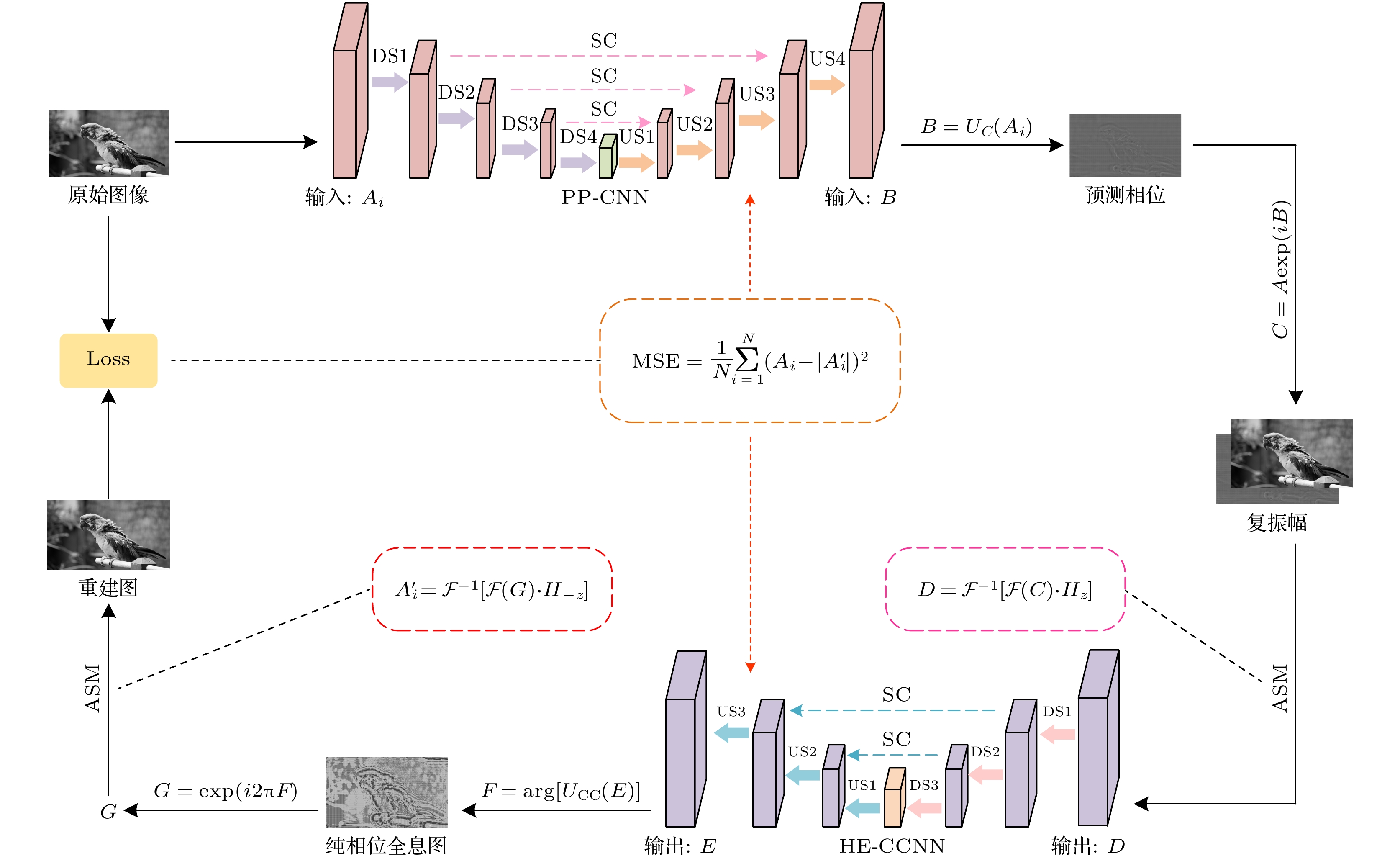
 下载:
下载:
